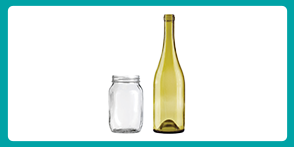Kerbside recycling: glass bottles and jars
What can go into your council kerbside recycling is now the same across Aotearoa. Find out about glass bottles and jars.
What can go into your council kerbside recycling is now the same across Aotearoa. Find out about glass bottles and jars.

Remove the lid.
Rinse dirty food jars to get rid of the remaining food.
Lightbulbs are made from more than one material.
Window glass is too large and easily broken to be safely collected and recycled through your kerbside collection. It may also contain other materials (eg, laminated or safety glass).
Broken glass is hazardous to sorters.
Lids are too small for recycling machinery to remove and sort.
Just because these items can’t be recycled at kerbside doesn’t mean you can’t recycle them.
Mitre10 collects old lightbulbs in its stores.
Lightbulb recycling [Mitre 10 website]
Donate unwanted glasses, mugs and plates to your local charity store.
Ask your council where you can recycle other glass items that can’t go in your kerbside recycling.
Most of the glass collected is turned into new glass bottles in Auckland.
In some parts of the country glass is crushed and reused:
According to the Glass Packaging Forum, in Aotearoa: